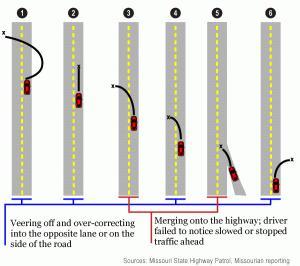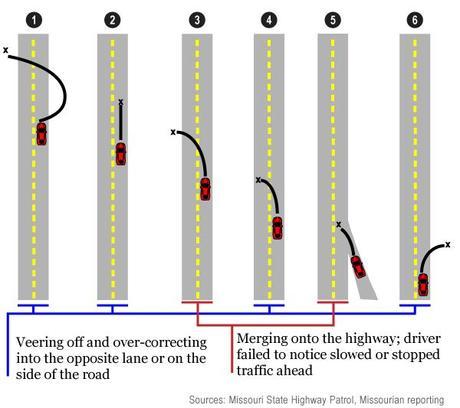 Troop F of the Missouri State Highway Patrol includes approximately 13 counties. In a recent article published by The Missourian, six trends were identified by the MSHP in fatal crashes. According to the Missouri State Highway Patrol, inattention is the leading cause of accidents. Drivers veer off and over-correct into the opposite lane or on the side of the road. Accidents also commonly occur when merging onto the highway or when drivers fail to notice slowed or stopped traffic ahead. About 70 percent of fatal accidents fall into one of those categories. In Troop F of MSHP, there were 1,457 crashes last year. According to online traffic crash reports, of those crashes, 66 resulted in 73 deaths.
Troop F of the Missouri State Highway Patrol includes approximately 13 counties. In a recent article published by The Missourian, six trends were identified by the MSHP in fatal crashes. According to the Missouri State Highway Patrol, inattention is the leading cause of accidents. Drivers veer off and over-correct into the opposite lane or on the side of the road. Accidents also commonly occur when merging onto the highway or when drivers fail to notice slowed or stopped traffic ahead. About 70 percent of fatal accidents fall into one of those categories. In Troop F of MSHP, there were 1,457 crashes last year. According to online traffic crash reports, of those crashes, 66 resulted in 73 deaths.
Of the 73 people who died, 52 of them were driving when the crash occurred. Futhermore, according to the MSHP, the number of fatalities is largely due to drivers not wearing their seat belts, but driver distraction also played a role in the majority of crashes. Sgt. Paul Reinsch said, “As far as which ones we’re seeing a lot of now, unfortunately a lot of texting and driving is a big problem”.
Breaking Down the 66 Fatal Crashes of 2014
- 11 occurred when the driver crossed the center line
- five occurred when the driver didn’t stop in time for the traffic ahead
- eight happened when the driver ran off the right side of the road
- 12 occurred when the driver ran off the right side of the road then over-corrected and ran off the left side of the road
- nine happened when the driver failed to yield to merging or crossing traffic
A total of 45 of the 66 crashes fit the above descriptions.
Seatbelt Usage
About 48 percent of the people killed in the above car crashes were not wearing seat belts, with another 5 percent of victims’ seat belt status unknown. The National Occupant Protection Use Survey (NOPUS) is the only survey that provides nationwide probability-based observed data on seat belt use in the U.S. According to NOPUS, seat belt use in 2013 reached 87 percent, statistically unchanged from 86 percent in 2012. The report showed increased trend in use since 1995 accompanied by a steady decline in the percentage of unrestrained passenger vehicle occupant fatalities during daytime. Other results of the study:
- Seat belt use for occupants in heavy traffic increased significantly from 89 percent in 2012 to 90 percent in 2013.
- Seat belt use in the Northeast increased significantly from 80 percent to 84 percent in 2013.
- Seat belt use continued to be higher in the States in which vehicle occupants can be pulled over solely for not using seat belts (“primary law States”) as compared with the States with weaker enforcement laws (“secondary law States”) or without seat belt laws. Currently, Illinois is a “primary law State” and Missouri is a “secondary law State”.
The Midwest had an 85 percent seat belt usage rate in 2012 and 2013 and the West had a 94 percent to 93 percent usage rate which was higher. The South and the Northeast both saw significant increases by 4 percent and 2 percent respectively. The data support that “primary law States” have a greater percentage of seat belt use than “other law States”. If you observe and tally the number of fatalities in the Missouri State Highway Patrol traffic crash reports, comparing restrained vs. unrestrained occupants in car crashes, it becomes apparent that there are more fatalities among unrestrained occupants in a car crash. When unrestrained, it is far more common for occupants to be thrown from a vehicle in a crash. More Seat Belt Statistics
- Research has shown that lap/shoulder seat belts, when used, reduce the risk of fatal injury to front-seat passenger car occupants by 45% and the risk of moderate-to-critical injury by 50%.
- Ejection from the vehicle is one of the most injurious events that can happen to a person in a crash. In fatal crashes in 2008, 77% of passenger vehicle occupants who were totally ejected from the vehicle were killed.
- Among passenger vehicle occupants over the age of 4, seat belts saved an estimated 13,250 lives in 2008. If all passenger vehicle occupants over the age 4 had worn seat belts, 17,402 could have been saved.
- Injury avoidance was the most frequent reason given fro wearing a seat belt.
- The most common reasons given by drivers in the 16-20 age group for not wearing seat belts were that they forgot or were driving a short distance.
Inattentiveness
Nearly 80% of traffic crashes involved driver inattention in a major study conducted by the National Highway Traffic Safety Administration (NHTSA) and the Virginia Tech Transportation Institute (VTTI). The 100-Car Naturalistic Driving Study tracked the behavior of the drivers of 100 vehicles equipped with video and sensor devices for over a year. During the research period, vehicles were driven nearly 2 million miles with 42,300 hours of data. “The most common distraction for drivers is the use of cell phones”, reports the study. Crashes attributed to talking was almost equal to those attributed to dialing.
Drowsiness is another significant problem and increases the driver’s risk of crash by a factor of at least four, but drowsy driving appears to be under reported in police crash investigations and reports. Inattentive driving is generally the failure to pay proper attention to the road while driving. It includes many behaviors such as talking, eating, putting on make up and attending to children. Of course, using cell phones and other wireless devices are considered an increasing trend in inattentiveness. When we hear statistics on seat belt use and that inattentiveness is the most common cause of motor vehicle crashes, we are not surprised. But what do we do about it? We can petition for law enforcement to enforce seat belt laws and we can encourage others to focus when they drive and put down their electronic devices. However, ultimately, the only person you can impact change is yourself. Each of us have to take responsibility for our actions when behind the wheel. As wearing a seat belt has been a law for quite awhile now, for most of us it has become second nature. The inattentiveness is a harder challenge that each of us have to make a conscious effort to reduce. Put your phone in the glove box or in another location you cannot reach while driving. Refraining from surfing the net or returning a text can make a big difference in the number of minor and major crashes that result in an incredible amount of injuries every year.
If you have been in a car accident and were injured, you will probably need legal representation. If you were not injured, then you probably do not need a personal injury attorney. Obviously, if you were under the influence or reckless, you may have criminal charges in which case, you will need a criminal defense attorney. Our attorneys represent people who have been injured in car and or truck crashes. We understand that minor and major motor vehicle crashes can have serious injuries that require weeks, months or years of medical treatment. Call locally (314) 276-1681 or toll free (800) 685.3302 for your free consultation.
Summary
